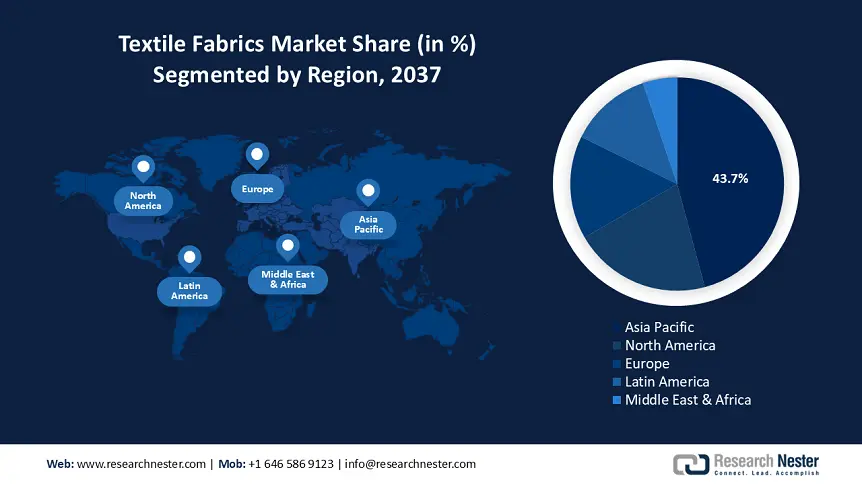Textile Fabrics Industry - Regional Synopsis
APAC Market Statistics
Asia Pacific textile fabrics market is projected to hold revenue share of over 43.7% by the end of 2037. The market is majorly expanding in the region due to the growing population, rising disposable incomes, and the increased need for higher-quality textile items. According to the United Nations Population Fund, approximately 4.3 billion people, or 60% of the world's population, live in the region, home to China and India, the two most populous nations on Earth. Furthermore, some of the biggest textile fabric producers in the world, including China, India, and Pakistan, are located in the region.
In India, the government’s proactive initiatives and policies are one of the primary factors propelling textile fabrics market growth. For instance, with an approved expenditure of USD 12.60 billion, the government launched the Production Linked Incentive (PLI) Scheme in 2020 to encourage the nation's production of MMF apparel, MMF fabrics, and technical textile products, allowing the textile industry to grow and become competitive. Moreover, the nation is enhancing its textile manufacturing capabilities through the adoption of e-commerce and ongoing machinery upgrades, which has helped the textile industry grow and become more competitive.
China is the world's largest textile exporter with yearly export earnings of USD 293.6 billion in 2023 and an annual GDP share of 8.7%. The textile sector employs about 8 million people. National marketplaces supply the majority of the raw materials. A significant portion of the manufacturing is for the domestic textile fabrics market, in addition to the export of primarily higher-quality goods. Also, textile companies are increasingly accelerating their digital transformation through advances in artificial intelligence (AI), 5G, and industrial internet. Additionally, the nation is seeing a greater degree of sector consolidation.
North America Market Analysis
North America will hold a significant share of the textile fabrics market in 2037. The growing demand for outdoor clothing and fabric t-shirts significantly supports the market's growth. It is also well known for its apparel, yarns, furniture, textiles, and raw materials.
In the U.S., automation, artificial intelligence (AI), and 3D printing are technological innovations transforming the textile manufacturing sector. These advancements provide higher-quality products, lower production costs, and greater efficiency. AI and automation make the industrial process, accurate and reliable, reducing waste and maximizing resource utilization. Furthermore, customers can easily acquire a wide range of textile products, including home textiles and apparel, through online retailing. Direct-to-consumer sales methods, effective inventory management, and customized shopping experiences are all made possible by the digital transition.
Technical textiles are developing in Canada in a business climate that is bolstered by scholarly research and solid industry expertise, which is favorable to the sector's continued expansion. Due to developments in the global textile industry, textiles are now more competitive with other materials, such as metals, wood, and plastics, for uses that have historically been reserved for these other materials.


